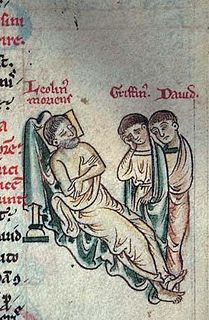
Llywelyn ap Gruffudd, sometimes written as Llywelyn ap Gruffydd, also known as Llywelyn the Last, was the native Prince of Wales from 1258 until his death at Cilmeri in 1282. Llywelyn was the son of Gruffydd ap Llywelyn Fawr and grandson of Llywelyn the Great, and he was one of the last native and independent princes of Wales before its conquest by Edward I of England and English rule in Wales that followed.

Llywelyn the Great, full name Llywelyn mab Iorwerth), was a King of Gwynedd in north Wales and eventually "Prince of the Welsh" and "Prince of Wales". By a combination of war and diplomacy he dominated Wales for 45 years.

The Kingdom of Gwynedd was a Welsh kingdom and a Roman Empire successor state that emerged in sub-Roman Britain in the 5th century during the Anglo-Saxon settlement of Britain.

The Kingdom of Powys was a Welsh successor state, petty kingdom and principality that emerged during the Middle Ages following the end of Roman rule in Britain. It very roughly covered the northern two-thirds of the modern county of Powys and part of today's English West Midlands. More precisely, and based on the Romano-British tribal lands of the Ordovices in the west and the Cornovii in the east, its boundaries originally extended from the Cambrian Mountains in the west to include the modern West Midlands region of England in the east. The fertile river valleys of the Severn and Tern are found here, and this region is referred to in later Welsh literature as "the Paradise of Powys".
Owain ap Gruffudd was brother to Llywelyn ap Gruffudd and Dafydd ap Gruffudd and, for a brief period in the late 1240s and early 1250s, ruler of part of the Kingdom of Gwynedd.

Dafydd ap Llewelyn ap Hywel, better known as Dafydd Gam, anglicized to David or Davy Gam, was a Welsh warrior, a prominent opponent of Owain Glyndŵr. He died at the Battle of Agincourt fighting for Henry V, King of England in that victory against the French.

Bleddyn ap Cynfyn, sometimes spelled Blethyn, was an 11th-century Welsh king. Harold Godwinson and Tostig Godwinson installed him and his brother, Rhiwallon, as the co-rulers of Gwynedd on his father's death in 1063, during their destruction of the kingdom of their half-brother, Gruffydd ap Llywelyn. Bleddyn became king of Powys and co-ruler of the Kingdom of Gwynedd with his brother Rhiwallon from 1063 to 1075. His descendants continued to rule Powys as the House of Mathrafal.
Tomas ap Rhodri or Thomas Rothery was the only known son of Rhodri ap Gruffudd, the youngest son of Prince Gruffydd ap Llywelyn Fawr and younger brother to both Llywelyn ap Gruffudd and Dafydd ap Gruffydd. After the deaths of Llywelyn, Dafydd, and their eldest brother Owain the Red between 1282 and 1283, Rhodri became the most senior member of the Aberffraw Dynasty to retain his liberty because he had sold his rights of succession to his brother Llywelyn around 1270 before he had had any children of his own. Tomas did not make any claim himself to the throne of Gwynedd.
Gruffydd ap Gwenwynwyn was a Welsh king who was lord of the part of Powys known as Powys Wenwynwyn and sided with Edward I in his conquest of Wales of 1277 to 1283.
Llywelyn ap Dafydd (c.1267–1287), potential claimant to the title Prince of Gwynedd, was the eldest son of Dafydd ap Gruffydd, the last free ruler of Gwynedd, and his wife Elizabeth Ferrers.
This article is about the particular significance of the century 1201–1300 to Wales and its people.
This article is about the particular significance of the century 1101–1200 to Wales and its people.

Wales in the High Middle Ages covers the 11th to 13th centuries in Welsh history. Beginning shortly before the Norman invasion of the 1060s and ending with the Conquest of Wales by Edward I between 1278 and 1283, it was a period of significant political, cultural and social change for the country.

The history of Gwynedd in the High Middle Ages is a period in the History of Wales spanning the 11th through the 13th centuries. Gwynedd, located in the north of Wales, eventually became the most dominant of Welsh polities during this period. Contact with continental courts allowed for Gwynedd to transition from a petty kingdom into an increasingly sophisticated principality of seasoned courtiers capable of high level deplomacy and representation; not only with the Angevine kings, but also the king of France and the Papal See. Distinctive achievements in Gwynedd include further development of Medieval Welsh literature, particularly poets known as the Beirdd y Tywysogion associated with the court of Gwynedd; the reformation of bardic schools; and the continued development of Cyfraith Hywel. All three of these further contributed to the development of a Welsh national identity in the face of Anglo-Norman encroachment of Wales.

Dafydd ap Gruffydd was Prince of Wales from 11 December 1282 until his execution on 3 October 1283 on the orders of King Edward I of England. He was the last native Prince of Wales before the conquest of Wales by Edward I in 1283 and English rule in Wales that followed.
The Lordship of Brecknock was an Anglo-Norman marcher lordship located in southern central Wales.








